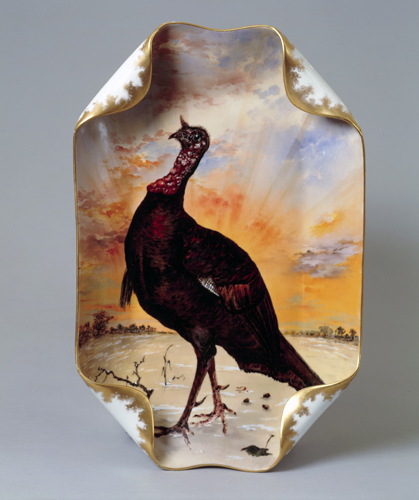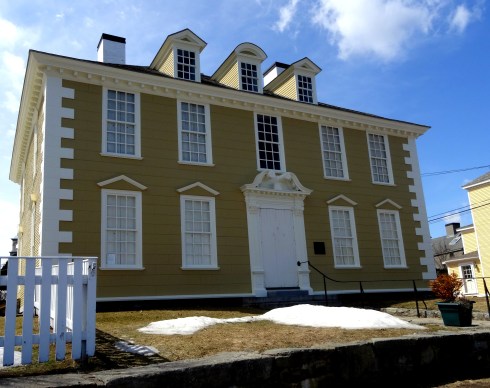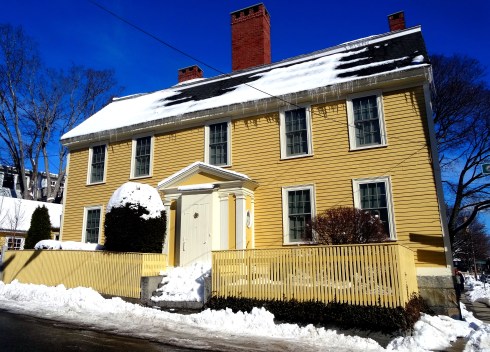Because I dislike Presidents Day so much (because of its ahistorical morphing of all the presidents together, thus denying their individual achievements, as well as the fact that it never seems to occur on the actual date of either Washington’s or Lincoln’s birthdays, the particular presidents it claims to commemorate), I’m going to downplay the historical and emphasize the material today with a very brief examination of Presidential china. The morphing of presidents is a very popular pastime today (see this viral video), but I prefer not to morph.
I spent (another) snowy afternoon looking through two books (Official White House China by Margaret Brown Klapthor and Susan Gray Detweiler’s American Presidential China. The Robert L. McNeil, Jr., Collection at the Philadelphia Museum of Art) and accessing two online sources (the White House Historical Association’s “Picturing the President’s House” digital series (so well done!) and the McNeil Americana Collection at the Philadelphia Museum of Art) and quickly formed an impression of presidential plates: those from the first century of the presidency are far more aesthetically pleasing and interesting than those from the second. Twentieth-century presidential china is, for the most part, boring.
Here are some of the early presidential plates, starting with that of the Washingtons, a gift to Martha from Dutch East India trader Andreas Everardus van Braam Houckgeest, who commissioned the design in Canton, China. I love the chain of 15 states, the state of the union in 1796. The service commissioned by James and Elizabeth Monroe from the French firm of Dagoty-Honoré is considered the first official White House china because of its patriotic motif: surrounding the eagle are five vignettes depicting Strength, Agriculture, Commerce, Art, and Science, the foundations of the new nation. Successive presidents apparently used the large Monroe service (400+ pieces) for big state dinners but also brought their own china into the White House for daily use: Mr. and Mrs. John Quincy Adams used this neoclassical service (with seahorse motifs), likely manufactured by the La Courtille Factory in Paris and purchased during Mr. Adams’ earlier diplomatic service in Europe, during their time in office.



Porcelain plates used during the Washington, Monroe, and Adams administrations, McNeil Americana Collection, Philadelphia Museum of Art.
There is no doubt that the star of early presidential china was the set purchased by James and Dolley Madison from the Nast Factory in Paris: an absolutely stunning (and modern!) design featuring wheels, of all motifs. It seems to be very sought after; at first I thought this was because of its relative rarity, given the fact that the Madison White House was burned down by the British in 1814. But it seems like most of the service survived (did Dolley sneak it out in the last hours, along with that great portrait of George Washington?), so I think its value must be based on the unusual design. I love it, and am even tempted to buy a copy–nearly every presidential library’s shop, including the JFK Library here in Massachusetts, seems to offer reproduction presidential china produced by Woodmere.



The Madison China, purchased c. 1806 from the Nast Factory in Paris. Plate and sauce boat, Philadelphia Museum of Art; dessert cooler, White House Historical Association.
The Lincoln “Royal Purple” china, pictured below on the cover of Detweiler’s book, was certainly expensive, like most of Mary Todd Lincoln’s White House “improvements”, but it seems to have stood the test of time and was supplemented and complemented by later sets. The scalloped shape set it apart from its predecessors, and like all White House china commissioned before 1918, it was made in France, by Haviland.

In terms of their china choices, the two most innovative, or nationalistic (as well as naturalistic), first ladies were Lucy Webb Hayes and Caroline Harrison. Quite by chance, Mrs. Hayes met an artist and reporter for Harper’s Weekly named Theodore R. Davis who convinced her to use native American flora and fauna in the design of a new White House service in 1880; the end result, designed by Davis in collaboration with the Haviland Factory in Limoges, France, was a rather dramatic departure from the traditional styles of the mid-nineteenth century. A decade later, Mrs. Harrison incorporated the naturalistic theme in her own design, but also paid tribute to tradition with the eagle and stars, and to Mrs. Lincoln’s plates with the scalloped edge.



Soup plate and serving platter from the administration of Rutherford B. Hayes, designed by Theodore R. Davis in collaboration with the Haviland Factory, Limoges France, 1880, Philadelphia Museum of Art and White House Historical Association; A soup plate designed by Mrs. Benjamin Harrison (Caroline Lavinia Scott) and manufactured by Tressemanes and Vogt, Limoges, France, 1891.
With the arrival of the twentieth century we come to the era of domestic production (mostly by Lenox) and rather boring bands: lots of gold, along with blue (Roosevelt), green (Truman and Bush), red (Reagan), and yellow (Clinton). The only departure from these restrained designs seems to be the Johnson wildflowers. I’m not sure what the Obama plans are regarding china, but in the mean time, we do have the “Abraham Obama” tea set by Ron English ( I suppose I am engaging in a little bit of presidential morphing after all) and you can also custom order your own flowered presidential plate here; I might go for Teddy Roosevelt myself.


Like this:
Like Loading...



























































































































